It looks like you're using an Ad Blocker.
Please white-list or disable AboveTopSecret.com in your ad-blocking tool.
Thank you.
Some features of ATS will be disabled while you continue to use an ad-blocker.
share:

Greetings:
We have been sounding the alarm since [color=Chartreuse]3/11, and a good part of what has been posted heretofore has identified specific states in the US, and in general, spoke of a radiated
North America.
So, what’s up in Canada ?
19 March 2011
Cesium-137 plume forecast for North America and Europe up to March 24: France’s IRSN (VIDEO)
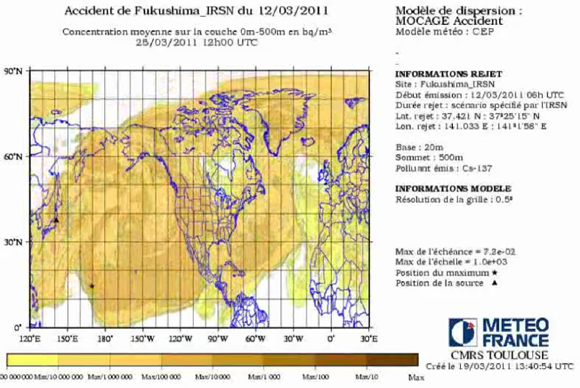
Any questions?
(...)The expected concentrations of cesium 137 in the air over the territory swept by the plume are extremely low.
This radionuclide is representative of radioactive material released long-distance during a nuclear accident.
Right. Based on what previous empirical data?
(...)
IRSN agreed with the Environment Protection Agency of the United States (EPA), which suggests that these concentrations will not affect health and the environment.
In addition, they will be so small that they may probably be detected in the environment than by sample measurements performed in specialized laboratories.(...)
So, we now have IRSN in collusion with the EPA, USGOV, TEPCO, JAPGOV, NOAA, NRC and the MSM to withhold vital, potentially life-saving information from we, the people - only one week into this disaster/fiasco.
19 March 2011
Fukushima nuclear plume 'covered most of North America'
The plume from Fukushima has now reached the western Atlantic but its radioactivity is likely to be “extremely low” and have [color=orane]no impact on health or the environment, France’s Institute for Radiological Protection and Nuclear Safety (IRSN) said on Saturday.
[color=8AFB17]'As of yesterday, the cloud covered most of North America and northeastern Siberia.
'It is currently passing over the North Atlantic,' it said, naming French terroritories in the Caribbean and off Canada’s eastern coast.
The cloud has been progressively thinning as it heads eastwards around the northern hemisphere at high altitude and will reach mainland Europe on Wednesday or Thursday, it said, citing a computer model jointly compiled with the French weather service, Meteo France. (…)
(...)
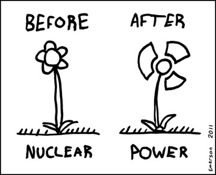
This is a video showing the current wind directions around the Fukushima nuclear disaster site with a wind and radioactive plume forecast in the second half of the video.
1 April 2011
Fukushima Forecast: Radioactive particles to be concentrated over Midwestern US on April 1, 2 (VIDEO)
And now, for something completely different - NUKESPEAK ...
* Although xenon is not toxic, its compounds are highly toxic -- CRC handbook of chemistry
4 April 2011
Canada suspends mobile radiation measurements around Vancouver, BC “until further notice” as radioactive cloud looms (VIDEO)
Health Canada, March 31, 2011:
• Mobile Survey of Saanich Peninsula March 22, 2011 0.37 [microseiverts/day]
• Mobile Survey of Victoria March 22, 2011 0.48 …
• Mobile Survey around Vancouver March 24, 2011 0.67 …
• Mobile Survey around Haida Gwaii March 24, 2011 0.73
• Mobile Survey around Vancouver March 25, 2011 0.72
Please note that there was no new data collected by NRCan on March 23, 2011, and that until further notice mobile surveys are suspended.
This is where it just boggles the mind that people are not in the streets and occupying the Health Canada offices.
Probably the same reason that it is not happening here in the U.S. - lack of critical information enabling the reader/activist to make informed decisions leading to awareness leading to empowerment leading to action.
To be continued ...

tfw
[align=center][color=magenta]Liberty & Equality or Revolution[/align]
edit on 8/11/2011 by thorfourwinds because: (no reason given)

Greetings:
This is where it just boggles the mind that people are not in the streets and occupying the Health Canada offices.
Probably the same reason that it is not happening here in the U.S. - lack of critical information enabling the reader to make informed decisions leading to awareness leading to empowerment leading to action.
Another example of blatant tomfoolery - this is what one get when one clicks on:
Nuclear Emergency Response
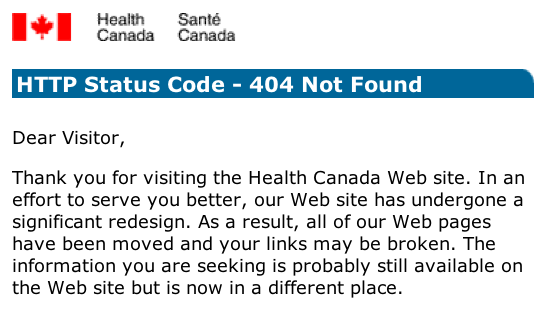
Same bravo sierra that the EPA presents on their website... obfuscation personified.
8 April 2011
Vancouver, Canada radiation tests show iodine-131 in rainwater at almost
100 times above US drinking water limit
… The jet stream is carrying the radiation from Japan to North America.
Most of the radioactivity disperses in the atmosphere and falls over the Pacific Ocean on its way over, but some of it has now reached the West Coast, falling down with rain, and mixing with seawater. It’s also accumulating in seaweed.
(...)
Bioaccumulation
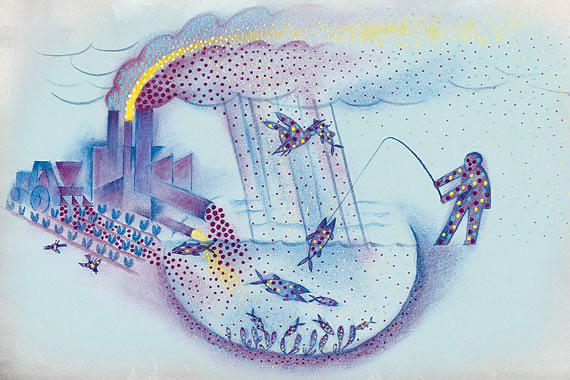
14 August 2011
Rainout of hot particles from radioactive clouds to continue for another year — Not just in Pacific Northwest, says Gundersen
...
• We’re going to see [color=Chartreuse]another year of these rainouts
• Rainout: When hot particles get dropped from radioactive clouds during rainstorms
• [color=Cyan]Officials say radiation levels are minute and present no health risk…
I am working with scientists who are publishing a paper that will definitively prove that to be wrong
• Rainouts are occurring not just in Pacific NW… we will continue to see rainouts...
23 August 2011
“We are basically recreating Fukushima all over again” — Clouds of radiation continue across to Pacific Northwest
• Lots of serious ramifications from burning of nuclear waste
• Material from Fukushima that was on the ground is now going airborne again
• Towns now getting cesium redeposited on them by the burning of nuclear material
• Clouds of radiation recontaminating areas deemed clean or low
• Continues across to the Pacific Northwest
25 August 2011
Canada nuke plant shuts down after two malfunctions —
‘Heavy water’ leaking for months unannounced to public
Quebec’s only nuclear power plant was shut down Tuesday night following two malfunctions, including a heavy water leak that Hydro- Quebec didn’t announce for two months.
Can we ask for some transparency here? Same old, same old...
A recuperation system overflowed on June 13 inside the Gentilly-2 plant, located 150 km northeast of Montreal.
Hydro-Quebec spokeswoman Flavie Cote [...] confirmed [color=Salmon]a second problem at the 48-year-old nuclear plant.
A pneumatic valve malfunctioned inside the reactor building. (...)
Again, only a few minutes (seconds) from another Fukushima disaster/fiasco... and, again, a problem with the cooling system!
6 September 2011
More on 'Second Fukushima' in progress for Japan and Pacific Northwest
What I see now is a second Fukushima occurring from burning radioactive waste…
[color=Chartreuse]Basically, the radioactive gases that settled on the ground are going to be thrown into the air and waft into other places in Japan and across the Pacific to British Columbia, Oregon and Washington…
20 September 2011
Canadians suspicious over radiation testing of seafood — Official “puzzled” - gov’t withholding where samples were taken
You just can't make this stuff up...
To be continued ...

tfw
[align=center][color=magenta]Liberty & Equality or Revolution[/align]
edit on 8/11/2011 by thorfourwinds
because: (no reason given)

Greetings:
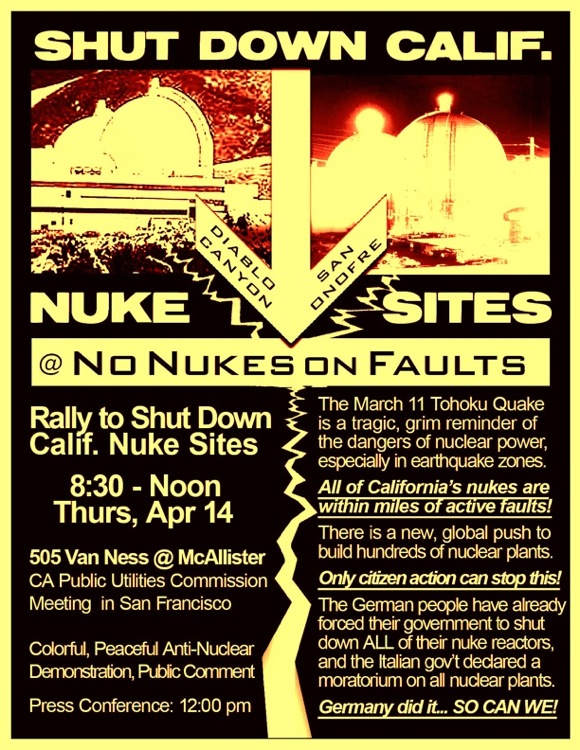
Think about the possibilities if enough people got the message... stay tuned.
(continued from previous post)
20 September 2011
Canadians suspicious over radiation testing of seafood —
Official “puzzled” - gov’t withholding where samples were taken
The Canadian Food Inspection Agency (CIFA) has deemed fish tested in the wake of the Japan nuclear disaster as radiation free, but will not divulge where samples were taken from. (...)
The agency did not answer repeated questions about where the samples were taken from in B.C., saying only that they were came from various processing stations. (...)
Stó:lō Tribal Council fisheries advisor Ernie Crey said he is puzzled at the agency’s reticence about where the fish were taken from.
[color=Cyan]'It’s this kind of response from government officials that give rise to suspicion among Canadians,' Crey told Indian Country Today Media Network.
'There is simply no good reason to withhold this information from the public.' (...)
20 October 2011
Now evidence has emerged that the radiation in Canada was worse than Canadian officials ever let on — [color=Chartreuse]Radioactive coverup?
[color=Cyan]'Public officials in Japan and Canada alike jumped straight into Chernobyl-style damage-control mode, dismissing any worries about impacts,' writes The Straight’s Alex Roslin.
The paper has obtained Canadian government data showing a monitoring station in Calgary detected an average of 8.18 Becquerels per liter of radioactive [color=Cyan]Iodine-131 in rainwater last March. This “exceeded Canadian guidelines” according to the paper.
[color=Chartreuse]Health Canada’s data on rainwater is “puzzling” because the test results it reported are much lower than the data of Simon Frazer University professor Krzysztof Starosta.
“He found [color=Cyan]Iodine-131 levels in rainwater in Burnaby (near Vancouver) spiked to 13 becquerels per litre in the days after Fukushima.
[Color=Chartreuse]'That’s many times higher than the levels detected in Vancouver by Health Canada.'
28 October 2011
“High concentrations” of radiation hit US and Canada — Plume was rich in Cesium-137 and “close to the surface” from Vancouver southward — See also Hawaii, Florida
• “Already on 15 March, a first isolated [color=Cyan]Xenon-133 cloud reached western North America, followed by the arrival of high concentrations of both [color=Cyan]Xenon-133 and [color=Cyan]Cesium-137 on 19 March.”
• “The main part of the radioactive plume entered western North America on 17–18 March.
On 18 March at 12:00UTC, the head of the plume had already arrived over the North Atlantic, but the main part was located over the eastern Pacific Ocean and western North America, where it could be detected at monitoring sites.
[color=Cyan]This part of the plume was also rich in Cesium-137, as it was still close to the surface south of 50 (Most of US/Canada border is 49°).
At the same time, the plume penetrated the subtropics and arrived at Hawaii on 19 March.”
• “A map of the simulated surface concentrations of [color=Cyan]Xenon-133 for 22 March shows that
[color=8AFB17]all of western North America was engulfed by the Fukushima Daiichi Nuclear Power Plant plume, as well as parts of eastern North America and eastern Asia.”
And we would like to share this, as we were a few of the 40,000 (peace) activists at Avila Beach in 1979 and 1981 who said ENOUGH and we are back!
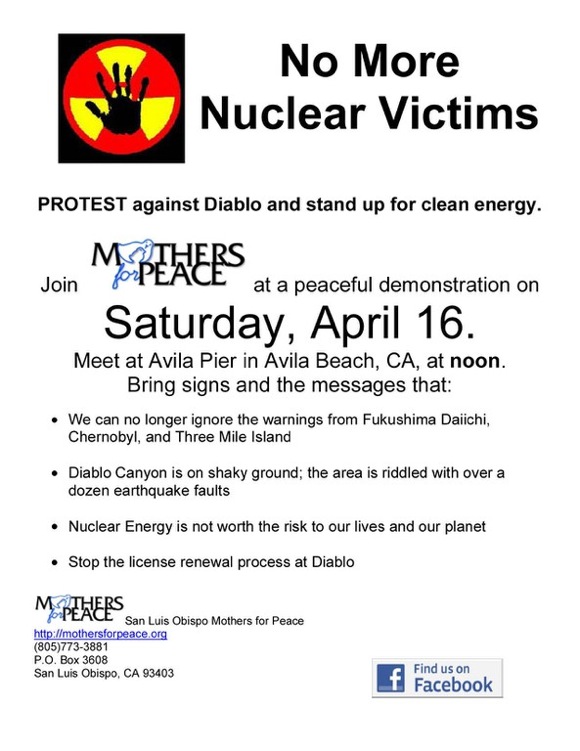

San Luis Obispo Mothers for Peace is a non-profit organization concerned with the local dangers involving the Diablo Canyon Nuclear Power Plant, and with the dangers of nuclear power, weapons and waste on national and global levels.
Additionally, Mothers for Peace concerns itself with issues of peace, social justice and a safe environment.
To be continued ...

tfw
[align=center][color=magenta]Liberty & Equality or Revolution[/align]
edit on 8/11/2011 by thorfourwinds
because: (no reason given)
Well, well, Berkeley caught lying again. 700% this time in Kansas.
enenews.com... evels-reported-by-uc-berekely
And yes I agree. An Occupy Health Canada is long overdo.
enenews.com... evels-reported-by-uc-berekely
And yes I agree. An Occupy Health Canada is long overdo.

Greetings:
Not that we would ever say, "we told you so," but ...
6 November 2011
Expert on Fukushima radiation in US: [color=3BB9FF]‘We know its going to impact public health’
• It’s more a matter of something happened that we didn’t want to happen.
•
• We know its going to impact public health.
•
[color=Cyan]• There’s not a whole lot you can do about it.
•
• Once you let the horse out of the barn, hell, the horse took the barn door with it.
•
• We’re stuck, this is an accident that should have been prevented. It’s hard to respond to it.
And now, for something completely different:
Japan TV host diagnosed with acute lymphocytic leukemia —
Had been eating Fukushima produce on show
You just can't make this stuff up folks...
And from April, a supercilious post that really attracted our attention to the apparent ignorance and insensitivity that blocks the sheeple's reality of [color=8AFB17]the true horror of the Fukushima multiple melt-through nuclear disaster/fiasco spewing life-altering radiation 24/7/365 [color=8AFB17]with no end or solution in sight.
[color=Salmon]And so what, the Japanese will have a few babies born limbless or with blotchy skin,
they will adapt to their environment.
You're joking, right?
My wife is Japanese, my in-laws are Japanese, and many of the surviving in-laws did time in Tehachapi and we do not appreciate your attempt at levity or derailment.
If you do not think anything is wrong, you eat the yellow snow and drink the milk.
[color=Salmon]Now just to clear the air, i do not like what is going on over there but we cannot help the situation playing keyboard tag with the mongering of fear.
Speak for yourself.
"Playing keyboard tag," as you call it, just might invigorate enough concerned citizens to get up off their lazy butts, turn off American Idol, Dancing With the Stars and Cupcake Wars and
question authority.
We certainly hope so. We are. OPERATION SURVIVAL is a working title for a project in bloom and a natural outgrowth of our Alliance roots. Stay tuned and you heard it here first.
As you can plainly see, dear reader, there is a lot of (re)education to be done to turn the tide in favor of life.
Meanwhile, the goalposts keep getting moved and acceptable collateral damage limits are steadily increased.
25 August 2011
Japan raising radiation limit to 20 millisieverts/year leads to 160,000 lifetime cancers per million people
In April, the Japanese government raised its maximum limit for children from one to 20 millisieverts per year, a level that leads to 2,270 cancers annually per million people (or 160,000 lifetime cancers per million), according to data in a landmark 2006 U.S. National Academy of Sciences report on radiation cancer risk.
A massive outcry later forced the government to reverse the move.
[color=8AFB17]About a fifth of the 1,600 schools in Fukushima prefecture were exposed to at least 20 milliseiverts of radiation this year, according to a Bloomberg story in July. [...]
The children already have a year's worth of radiation in 4 months at the 20 millisieverts per year!

Operation Survival
(How about the following for starters? (this is a work in progress - any input would be sincerely appreciated...)
We are a grassroots peace and environmental organization dedicated to sharing new ideas and vital information necessary for survival in this post 3/11 age.
We support converting our economy to safely fulfill human needs, creating a cleaner, safer and more humane world while working to make the connections between peace, social justice and environmental responsibility.
We think this foto says it all... these are the real OWS'ers (IMHO) and us 30 years ago at Diablo...they should have left sleeping dogs lie... will you join us?

We are not alone:
Australian Cannonball Nuclear News

tfw[align=center][color=magenta]Liberty & Equality or Revolution[/align]
edit on 8/11/2011 by
thorfourwinds because: (no reason given)
Since the beginning of the Fukushima situation, I've been keeping an eye on the Radiation Network website.
March 14th (before Pacific wind arrival):
March 29:
August 11:
November 14:
March 14th (before Pacific wind arrival):
March 29:
August 11:
November 14:
somebody with a 'my first geiger counter' bought off e-bay saying things like this...
i felt moved by universe to check the rads again.
hmmm.
Nov 14th rad readings from Durango Colorado.
www.youtube.com...
DD. I think a lot of folks don't trust those official numbers anymore. Whenever an area gets high numbers they seem to shut off that station. There have also been times where independents like this guy have gotten triple the "Official" number readings.
www.youtube.com...
DD. I think a lot of folks don't trust those official numbers anymore. Whenever an area gets high numbers they seem to shut off that station. There have also been times where independents like this guy have gotten triple the "Official" number readings.
Holy crap! Someone may have tried to blow Brunswick, on purpose!
From our independent civillian bud in Durango, Colorado, we some variations on radiation.
Well my dosimeter arrived last week, and Sunday night it rained. It's very different, seeing a u-tube video of someone elses readings, and having one
of these spike in your own living room.

Greetings:
How's this for a piece of good news?
Japan Times: People “fed up with the shroud of secrecy” in Fukushima —
Starting to smuggle in journalists — Must rely on media for help
“Increasingly, those forced from their homes as a result of the disaster, are fed up with the shroud of secrecy thrown over the Fukushima plant and the abandoned towns and villages where families had lived for centuries.”
The less media coverage there is, the more they worry that their plight will be forgotten—
and the less pressure there will be on Tepco to cough up proper compensation.
That appears to be one reason some are starting to take the law into their own hands and smuggling journalists into the forbidden zone.
And for those who scoff at bioaccumulation...
Fukushima health concerns | The Japan Times Online
The people who have been most affected by radiation from the Fukushima plant are workers,
both from Tepco and from subcontractors, who have been trying to bring the radiation-leaking plant under control.
In the nation's history, these workers rank second only to the victims of the atomic bombings of Hiroshima and Nagasaki in terms of their exposure to radiation, therefore the possibility cannot be ruled out that they will develop cancer.
Tepco and the central government must do their best to prevent workers' overexposure to radiation and take necessary measures should workers become overexposed to radiation.
[color=Chartreuse]It must not be forgotten that exposure to radiation has long-term effects on human health.
In the Hiroshima and Nagasaki atomic bombings, the number of leukemia cases started to increase among bombing survivors two years after the bombs were dropped.
In the case of the 1986 Chernobyl accident, thyroid cancer began to appear among children several years after the disaster happened.
[color=3BB9FF]Particular attention should be paid to the health of children.
This is a pivotal moment in history!
Pay particular attention to the following, please.
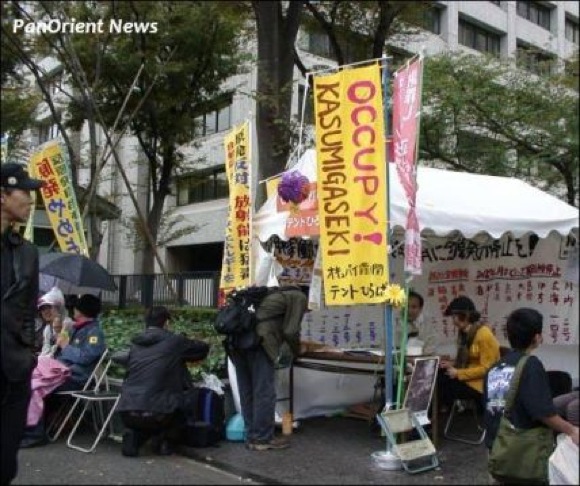
'Occupy' Movement Hits Japan —
Women camping in front of gov’t building in Tokyo calling for end to nuclear
“Women representatives from all over Japan are camping in Kasumigaseki district in Tokyo to express their objection to the nuclear power plants in Japan in the wake of the Fukushima nuclear disaster.” (...)
The activists held banners saying We Are Anti-Nuclear, and Don’t Restart Nuclear Plants.
One of the banners said “Occupy Kasumigasaki,” the district in Tokyo where government buildings are concentrated.
The anti nuclear energy movement is gaining more support among Japanese civilian groups
[color=Chartreuse]as the crisis in the crippled Fukushima nuclear power plants has not been solved.
And that’s a good thing... just imagine an event that brings together ALL like-minded individuals world-wide to share one voice ... stay tuned to OPERATION SURVIVAL.
[color=Chartreuse]Reports bring daily news of radioactive leaks and contamination with materials such as radioactive cesium in various part of the country.
[color=3BB9FF]The anti-nuclear activists, however, are calling on the government to activate alternative and clean energy technologies and phase out the nuclear reactors.
[align=center][color=Violet]The following is so disturbing that we have refrained from posting it thus far,
but the Fukushima disaster/fiasco warrants total transparency,
no matter how difficult reality is to behold.[/align]
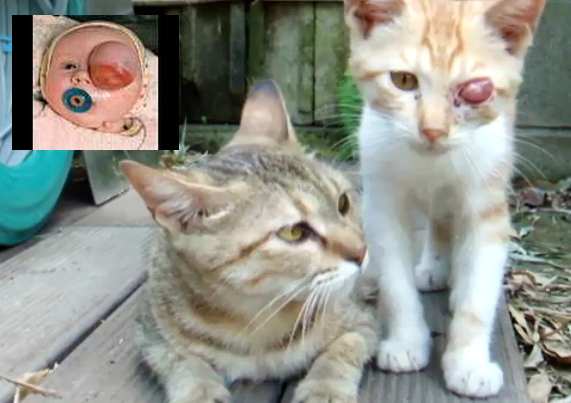
Japanese kitten with deformed eye — Similar to Chernobyl victims
UPDATE: Eye swelling a symptom of thyroid disorder -- I often hear how childrens' eyes become swollen after being in radiation-contaminated sandboxes, says Japanese organizer...
Any questions?

tfw
[align=center][color=magenta]Liberty & Equality or Revolution[/align]
new topics
-
Cold Blooded Killers on Christmas!! GRRRRrrr!!
Pets: 2 hours ago -
Plane Crash Today --Azerbaijanian E190 passenger jet
Mainstream News: 7 hours ago -
Orange County Makes Shoplifting a Felony
Other Current Events: 11 hours ago
top topics
-
Orange County Makes Shoplifting a Felony
Other Current Events: 11 hours ago, 16 flags -
It's Offical Now
US Political Madness: 13 hours ago, 15 flags -
The reason it works is.....
General Chit Chat: 14 hours ago, 8 flags -
Dick Van Dyke saved from Wildfire by neighbours on his 99th birthday
People: 16 hours ago, 7 flags -
Plane Crash Today --Azerbaijanian E190 passenger jet
Mainstream News: 7 hours ago, 6 flags -
Cold Blooded Killers on Christmas!! GRRRRrrr!!
Pets: 2 hours ago, 5 flags
active topics
-
Statements of Intent from Incoming Trump Administration Members - 2025 to 2029.
2024 Elections • 52 • : WeMustCare -
-@TH3WH17ERABB17- -Q- ---TIME TO SHOW THE WORLD--- -Part- --44--
Dissecting Disinformation • 3811 • : 777Vader -
Cold Blooded Killers on Christmas!! GRRRRrrr!!
Pets • 5 • : rickymouse -
Plane Crash Today --Azerbaijanian E190 passenger jet
Mainstream News • 12 • : rickymouse -
It's Offical Now
US Political Madness • 15 • : Imhere -
Political Warfare & The Resister Special Forces Underground
Political Ideology • 2 • : NoCorruptionAllowed -
London Christmas Market BANS Word ‘Christmas’
Social Issues and Civil Unrest • 49 • : NorthOS -
Post A Funny (T&C Friendly) Pic Part IV: The LOL awakens!
General Chit Chat • 7956 • : KrustyKrab -
Drones everywhere in New Jersey ---and Elsewhere Master Thread
Aliens and UFOs • 229 • : yuppa -
DefCon Teetering on Escalation
World War Three • 49 • : ADVISOR


